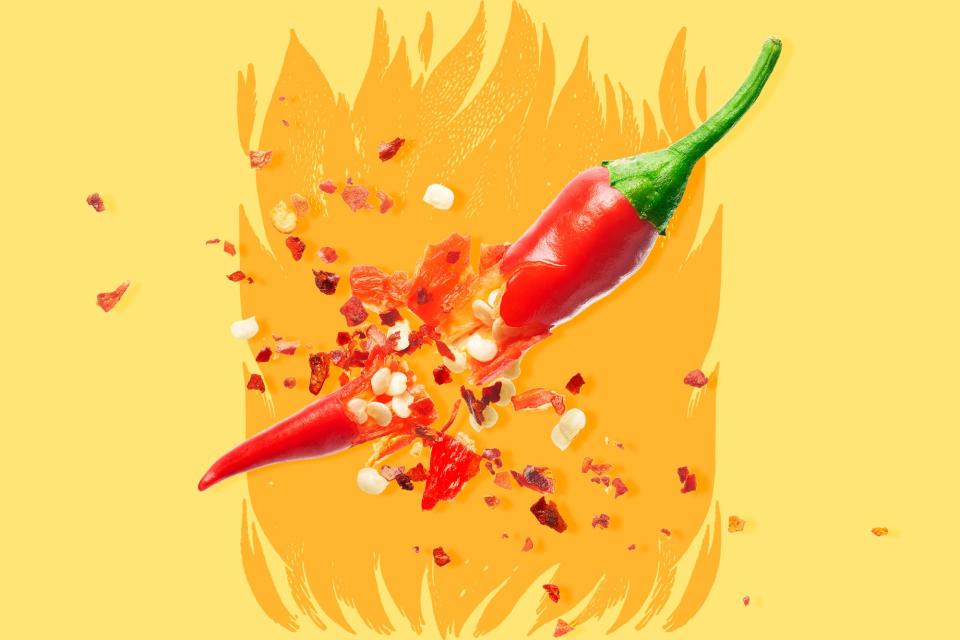6 Tips to Fix Dishes That Are Too Spicy

Getty Images / phive2015 / CSA-Printstock
Even those of us who cook every day have occasional slip-ups in the kitchen. Dishes may sometimes turn out too salty, too tart, too sweet or too spicy—especially if you are sensitive to spice. There are few things worse than sitting down for a meal only to realize the dish is above your preferred tolerance level. There are ways to stop your mouth from burning if you choose to power through, like drinking milk or eating ice cubes. But better yet, there are ways to adjust a dish while you're cooking to help tamp down the spice level (yet another reason to taste your food often). Check out these six ways to salvage a dish that's too spicy before it even makes it to the table.
Related: 28 Dinner Recipes for When You're Craving Something Spicy
1. Add Dairy
There's a lot of hype about using milk to help provide relief from spicy foods, and for good reason. The sometimes intensely hot sensation of spice we feel as spiciness comes from a chemical called capsaicin. Commonly found in chile peppers, capsaicin binds to our tongues and causes a painful sensation that we interpret as spicy. Milk and dairy products contain a protein called casein that is able to bind with capsaicin before it reaches our tongue, so it can reach fewer receptors, and lessens the sensation of spice. If your dish is too spicy, try adding heavy cream, yogurt, sour cream or butter to help mellow it out.
2. Use Citrus
Capsaicin is an alkaline molecule, so pairing it with something acidic like citrus juice or vinegar can help neutralize some of the heat. Dairy products are also acidic, which is another reason why they are effective at tempering spice. The next time your dish tastes too spicy, try adding lemon, lime or orange juice, or any style of vinegar that suits the dish and your taste preferences. Remember, a little goes a long way, so taste as you go (it's always easier to add more than to backtrack after adding too much).
3. Add Nuts or Nut Butters
High-fat foods like nuts and nut butters can help dissolve the oils in capsaicin, making the spice feel less potent. Adding a scoop of nut butter can not only help neutralize excessive spice, but also adds protein, healthy fat and nutrients to whatever you're making. This gives us yet another reason to make sure we have peanut butter in our pantries.
4. Sprinkle in Sugar
You might be familiar with the Scoville scale that measures the spice level of chile peppers. What you might not know is that the unit used to rank peppers, called a Scoville Heat Unit, is identified by how much of a sugar-water solution is needed to neutralize the spice in a taste test. Sugar is yet another kitchen staple that can help quell a dish that is a little too hot. Sprinkle in some granulated sugar, brown sugar, honey or maple syrup to get the desired effect and flavor.
5. Add Starch or Grains
Another great way to lessen the concentration of spice in a dish is to pair it with carbs. Getting a bit of rice or potatoes in each bite can help make the spice levels more manageable. Even serving a slice of bread on the side can offer respite from the heat (bonus points if you put butter on your bread to add some casein).
6. Dilute It
Another simple way to temper something spicy is to dilute it. This can be done by adding more of the non-spicy ingredients to a dish (like vegetables, grains, meat or broth) or even just by adding water to thin it out. A dish that seems inedibly spicy at six servings might be pleasant when it's stretched out to eight servings. This method works best with soups, stews and casseroles, but also can be applied to any sauce being used for a dish.

